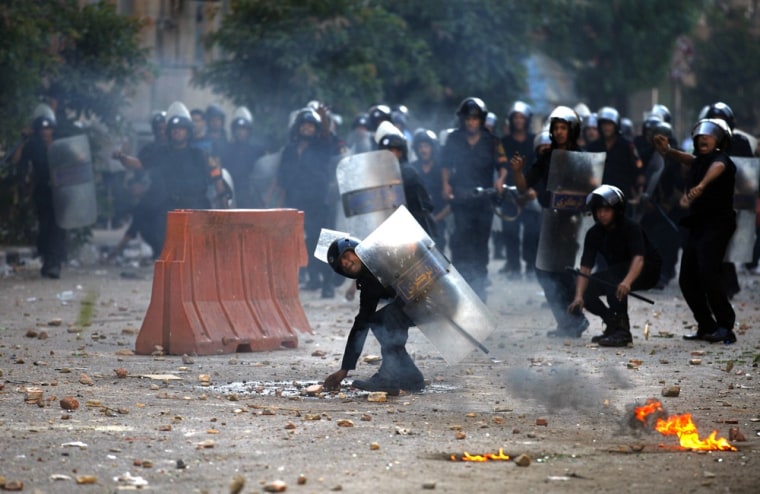Egyptian security forces clashed for a second day in Cairo with hundreds of youths demanding that the country's military rulers speed up prosecution of police officers accused of brutality during mass protests that forced Hosni Mubarak to step down. More than 1,000 people were injured in the fighting at Tharir Square, a senior official said.
In scenes reminiscent of the 18-day uprising that ousted Mubarak early this year, riot police deployed around the Interior Ministry building fired in the air or used tear gas as demonstrators threw rocks and firebombs.
The fighting left streets littered with rocks and debris. A heavy white cloud of tear gas hung over the area.
By late afternoon, army troops backed by armored vehicles took over from riot police who had been protecting the Interior Ministry, closing all roads leading to the complex, the official Middle East News Agency, MENA, reported.
MENA quoted Assistant Health Minister Abdul-Hameed Abazah as saying that of the injured, some 900 were treated on the spot and more than 120 went to hospitals.
The protests attest to the continuous upheaval in Egypt as the country grapples with a worsening economic crisis and as a security vacuum that has led to a surge in crime.
It was the first such violence in weeks in Tahrir Square, the center of the revolt that led to Mubarak being toppled.
The question of serving justice to those responsible for the deaths of the some 850 protesters during the uprising and the regime stalwarts charged with corruption is among the most divisive in post-Mubarak Egypt.
Many of those who took part in the uprising accuse the ruling military of showing too much reverence to key figures of the old regime and lenience with senior police commanders accused of ordering the killing of protesters.
"The people are angry that the court cases against top officials keep getting delayed," Ahmed Abdel Hamid, 26, a bakery employee, said at the scene. He clutched stones in his hands.
Others called for Field Marshal Mohamed Hussein Tantawi, head of the military council now ruling Egypt, to step down.
'Destabilize the country'
Security and hospital officials said 48 policemen and 132 protesters were hurt, with 60 hospitalized, in the clashes that began Tuesday.
Most suffered from gas inhalation or concussions, the officials said, speaking on condition of anonymity because they were not authorized to speak to the media.
Ambulances ferried the wounded to hospitals, and volunteer doctors and nurses treated others on sidewalks.
The military issued a statement on its Facebook page saying the clashes were designed to "destabilize the country" and drive a wedge between the groups behind the uprising and the security forces. It called on Egyptians not to join the protests.
Some of the protesters used scarves to fend off tear gas or stripped down to the waist.
They pelted police cars with rocks and advanced when the riot police lines retreated. But while the main chant back in January and February was "the people want to oust the regime," screams of "the people want to oust the field-marshal" dominated on Tuesday and Wednesday.
That was a reference to Tantawi, Mubarak's longtime defense minister and chairman of the Supreme Council of the Armed Forces that has taken over after the former president stepped down on Feb. 11. Tantawi is seen by some of the youth groups behind the uprising to be a key member of the Mubarak regime.
Critics also charge that Tantawi's policies are designed to keep the old order, and accuse him of deliberately stalling the process of purging Mubarak loyalists and failing to reform the hated Interior Ministry and its security agencies.
Human-rights abuses
The clashes are likely to widen the rift between many Egyptians and the police, blamed for most of the human-rights abuses during Mubarak's nearly three decades in power.
They also are likely to delay efforts aimed at empowering the police to fully take back the streets after their unexplained disappearance following deadly clashes with protesters during the uprising and the deployment of army troops in their place in late January.
Mubarak's security chief, former interior minister Habib el-Adly, is on trial along with several of his top aides for ordering the use of deadly force against the protesters.
This week, his trial was adjourned until July 25, a decision that touched off clashes between relatives and police deployed outside the courthouse. Some of the victims' relatives want Mubarak to be included in the case against el-Adly.
Mubarak has been under arrest at a hospital in the Red Sea resort city of Sharm el-Sheikh and has been separately charged with ordering the killing of the protesters. Both men face the death penalty if convicted. Mubarak's trial is due to start on August 3.
The clashes began Tuesday evening at Tahrir Square, the epicenter of the uprising, but later moved to streets leading to the nearby Interior Ministry when authorities ordered the riot police to pull back from the vast plaza.
There were an estimated 6,000 protesters at the peak of the riots late Tuesday night.
Tahrir Square was closed to traffic on Wednesday, but about 1,500 protesters still took to the streets, most near the Interior Ministry.
A key youth group, April 6, described the police's handling of the latest protests as "brutal" and called in a statement for a sit-in in central Cairo to protest what it said was the failure to implement many of the demands from the uprising and to show solidarity with the families of the uprising's victims.
